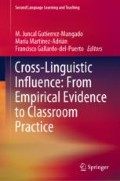Abstract
Language studies framed within sociocultural perspectives have claimed that the use of the first language (L1) in foreign language (FL) instruction settings can facilitate FL learning. This study inquired into the functions of L1 use in the oral production of Catalan/Spanish bilingual primary school learners (N= 20) and teachers (N= 2) of co-taught Content and Language Integrated Learning (CLIL) science sessions. Eight complete lessons that were taught by means of both the L1 (Spanish/Catalan) and the FL (English) were audio recorded and transcribed. The identified functions were quantified and classified into different interactional strategies so as to know which ones were mostly used by which participants. The direction of interaction between addressees and addressers was also analyzed to investigate if the lessons were teacher or student centred. The main findings indicated that this specific co-teaching model did not fulfill the objectives of CLIL approaches but L1 use was shown to be a beneficial tool serving the purpose of coping with CLIL linguistic and cognitive demands. Finally, pedagogical implications are discussed with regard to CLIL and collaborative teaching methodology.
Access this chapter
Tax calculation will be finalised at checkout
Purchases are for personal use only
Notes
- 1.
This refers to collaborative dialogue and the notion that individuals derive knowledge from social interaction. It is by the interaction of two or more individuals that language learning and knowledge development can (co-)occur while collaborative dialogue is taking place.
- 2.
This does not mean that the FL or a mixture of both the L1 and the FL cannot be used in private speech. It is likely that learners use a mixture of both languages during their learning process, especially as the proficiency level increases.
- 3.
When referencing their activity and interaction in the classroom setting, both teachers will be differentiated following this assumption, i.e., “content teacher” (abbrev. CT) will be the label for the one who normally teaches regular science lessons and speaks in Catalan, and “language teacher” (abbrev. LT) will be the label for the one who teaches regular EFL lessons and speaks in English.
- 4.
The part of the sentence that is emphasised in italics has been analysed as self-regulation. The first part of the sentence is included in order to understand the situation better, otherwise “és que no ho sé” could be interpreted as part of a metacognitive strategy. It is argued here that this sentence belongs to self-regulation, because the content teacher intervention is not fully focused on clarifying the meaning of the word “steel”. Rather, it is more focused on self-reflecting on her lack of knowledge in relation to a given word.
- 5.
Students used to interact with the language teacher much more than with the content teacher. Then, as students addressed teachers in their L1 almost by default, the percentage of students-language teacher interaction is much higher than with the content teacher. Hence, it is not the case that the students made an effort for addressing the content teacher in the FL (which might have been a fair interpretation derived from the data presented in Fig. 1).
Acknowledgements
We would like to express our gratitude to the school and the participants of this study, since it would not have been possible without their participation. We would also like to thank the EFLIC Research Group (2014SGR693, 2017SGR752), which also allowed us to collect the data for this study.
Author information
Authors and Affiliations
Corresponding author
Editor information
Editors and Affiliations
Rights and permissions
Copyright information
© 2019 Springer Nature Switzerland AG
About this chapter
Cite this chapter
Milán-Maillo, I., Pladevall-Ballester, E. (2019). Explicit Plurilingualism in Co-taught CLIL Instruction: Rethinking L1 Use. In: Gutierrez-Mangado, M., Martínez-Adrián, M., Gallardo-del-Puerto, F. (eds) Cross-Linguistic Influence: From Empirical Evidence to Classroom Practice. Second Language Learning and Teaching. Springer, Cham. https://doi.org/10.1007/978-3-030-22066-2_10
Download citation
DOI: https://doi.org/10.1007/978-3-030-22066-2_10
Published:
Publisher Name: Springer, Cham
Print ISBN: 978-3-030-22065-5
Online ISBN: 978-3-030-22066-2
eBook Packages: EducationEducation (R0)

